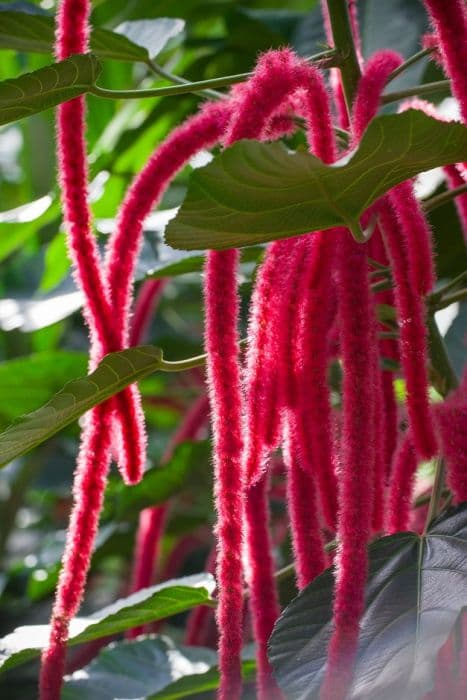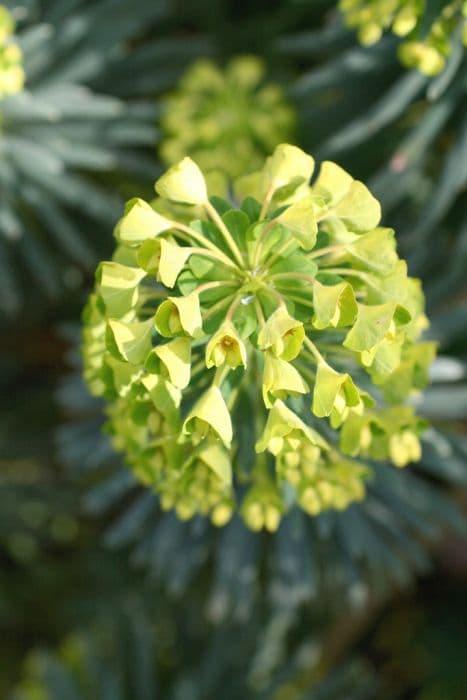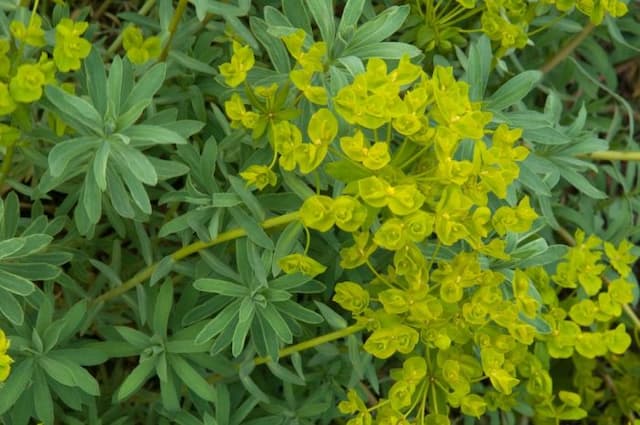Buddha Belly Plant Jatropha podagrica

ABOUT
The plant commonly known as Buddha Belly plant is unique and eye-catching with several distinct features. It is characterized by its swollen, bulbous stem which gives it a distinct "belly-like" appearance, hence one of its common names. The stem is typically a grayish color, though it may have a green tinge. The leaves of the Buddha Belly plant are large, lobed, and have a glossy texture, presenting a striking green color that can serve as a lush backdrop in any garden. These leaves usually grow in a rosette-like fashion at the top of the stem, creating a canopy-like effect. Adding to its visual interest, the Buddha Belly plant produces bright, coral-red flowers that dangle in clusters. These flowers provide a beautiful contrast to the green foliage and can be quite eye-catching when the plant is in bloom. The vivid coloring and unique shape of the blooms are often a draw for garden enthusiasts and pollinators alike. Overall, the Buddha Belly plant's distinctive swollen stem, large green leaves, and showy red flowers make it a notable and often talked-about addition to plant collections or as a standalone specimen in a garden. Its unusual shape and coloration make it a focal point wherever it is grown, without reference to its specific dimensions.
About this plant
 Names
NamesSynonyms
Buddha Belly Plant, Gout Plant, Guatemala Rhubarb, Gout Stalk, Purging-nut, White Rhubarb, Tartogo.
Common names
Jatropha podagrica Hook., Adenoropium podagricum (Hook.) Pohl, Jatropha podagrica var. typica Pax, Jatropha stimulosa Müll.Arg., Jatropha urens L.
 Characteristics
CharacteristicsLife cycle
Perennials
Foliage type
Deciduous
Color of leaves
Green
Flower color
Red
Height
3 feet (0.91 meters)
Spread
2 feet (0.61 meters)
Plant type
Shrub
Hardiness zones
10
Native area
Central America
Benefits
 General Benefits
General Benefits- Ornamental value: Jatropha podagrica, also known as Buddha belly plant, features unique swollen stems and bright red flowers that add aesthetic value to gardens and indoor spaces.
- Drought tolerance: Buddha belly plant is highly resistant to drought, making it an ideal choice for xeriscaping and arid climates where water conservation is necessary.
- Pest resistance: The milky sap within the plant serves as a natural deterrent to many common pests, minimizing the need for chemical pesticides.
- Low maintenance: Due to its ability to thrive with minimal care, Buddha belly plant is suitable for gardeners of all skill levels, including beginners.
- Easy to propagate: Buddha belly plant can be easily propagated from seeds or cuttings, making it a cost-effective choice for expanding gardens or sharing with others.
- Adaptability: It can grow in a variety of soil types, from sandy to loamy, as long as there is good drainage, representing a versatile option for different garden settings.
 Medical Properties
Medical Properties- Anti-inflammatory: Jatropha podagrica has been used in traditional medicine for its anti-inflammatory properties to help reduce swelling and pain.
- Antimicrobial: Extracts of the plant have shown antimicrobial activity against certain bacteria and fungi in some scientific studies.
- Analgelsic: The plant has been used to alleviate pain in traditional medicinal applications.
- Purgative: The latex of Jatropha podagrica has been used as a purgative to induce bowel movements.
- Anti-cancer: Some compounds in the plant have been researched for their potential anti-cancer properties, though these uses are not confirmed for clinical application.
- Wound healing: Applied topically, the latex has been traditionally used to aid in the healing of wounds.
 Air-purifying Qualities
Air-purifying QualitiesThis plant is not specifically known for air purifying qualities.
 Other Uses
Other Uses- Jatropha podagrica, commonly known as Buddha Belly Plant, can be used as a natural fencing material in tropical and subtropical regions due to its hardy and quick-growing nature.
- The milky sap of Buddha Belly Plant is occasionally used as a natural adhesive in small-scale crafting or for mending pottery in some cultures.
- Because of its unique shape and bold appearance, Buddha Belly Plant is often cultivated as a bonsai specimen, adding an exotic touch to this traditional art form.
- The flowers of Buddha Belly Plant can serve as temporary natural jewelry or adornments for festivals due to their bright appearance.
- Its distinct seed pods have been used in creating unique and artistic home decorations or as educational tools to demonstrate seed dispersal mechanisms.
- Some growers use the Buddha Belly Plant as a 'trap crop' to protect other plants from pests, due to its toxicity to some insects.
- In certain regions, the dried stems of Buddha Belly Plant are utilized in making lightweight yet sturdy fishing floats.
- The plant's unusual appearance and ability to thrive in tough conditions make it a suitable choice for xeriscaping, which requires minimal irrigation.
- Buddha Belly Plant is sometimes used in rituals or ceremonies, particularly within certain indigenous cultures that attribute spiritual significance to its unique form.
- Its dense foliage can provide a microhabitat for small wildlife, such as certain species of frogs and lizards, which find shelter in its leaves and stems.
Interesting Facts
 Feng Shui
Feng ShuiThe Buddha Belly Plant is not used in Feng Shui practice.
 Zodiac Sign Compitability
Zodiac Sign CompitabilityThe Buddha Belly Plant is not used in astrology practice.
 Plant Symbolism
Plant Symbolism- Caution or Danger: The Jatropha podagrica, commonly known as the Buddha Belly plant, contains toxic sap that can cause harm if ingested or if it comes into contact with skin, symbolizing the need for caution and awareness of potential danger.
- Resilience: The Buddha Belly plant is known for its drought tolerance and ability to survive in less-than-ideal conditions, making it a symbol of resilience and the ability to withstand tough circumstances.
- Uniqueness: With its distinctive swollen stem that resembles a Buddha's belly, the plant serves as a symbol of uniqueness and non-conformity, celebrating characteristics that stand out from the norm.
- Prosperity and Wealth: Sometimes associated with the Laughing Buddha, who is often depicted with a protruding stomach and symbolizes happiness, abundance, and wealth, the Buddha Belly plant can also serve as a symbol of prosperity and good fortune.
 Water
WaterBuddha belly plant requires careful watering to ensure it does not become waterlogged. It should be watered once the top inch of soil feels dry to the touch. Typically, this means watering approximately once a week, but it can vary depending on environmental conditions. When watering, add enough water to moisten the soil thoroughly; for a medium-sized pot, this might be around 8-16 ounces. Allow excess water to drain away, as standing water can lead to root rot.
 Light
LightBuddha belly plant thrives best under bright, indirect sunlight. It should be placed in a spot where it can receive plenty of light without being exposed to the harsh midday sun. A north or east-facing window is an ideal spot for the Buddha belly plant, providing it with the gentle morning or afternoon light it prefers.
 Temperature
TemperatureBuddha belly plant prefers warm temperatures; ideally between 60°F and 85°F. It can tolerate a minimum temperature of 50°F but must be protected from frost. Keep the plant away from drafty windows or vents that could expose it to colder temperatures which might cause stress or damage to the plant.
 Pruning
PruningPrune the Buddha belly plant to remove any dead or damaged leaves and to shape the plant for aesthetic purposes. Pruning should be done sparingly, and the best time for it is in the late winter or early spring before new growth starts. Use clean, sharp shears to make precise cuts, and remove no more than one-third of the plant at a time to prevent stress.
 Cleaning
CleaningAs needed
 Soil
SoilThe Buddha Belly Plant prefers a well-draining soil mix, rich in organic matter, with a pH level ranging from 6.0 to 7.5. A mix of peat, perlite, and compost is ideal for good growth and drainage.
 Repotting
RepottingBuddha Belly Plants should be repotted every two to three years or when they outgrow their current pot, which is when the swollen stem starts to overhang the pot's edges.
 Humidity & Misting
Humidity & MistingBuddha Belly Plant thrives at average room humidity levels, but it can tolerate lower humidity. It's best to maintain humidity around 40-50%.
 Suitable locations
Suitable locationsIndoor
Place Buddha Belly Plant in bright, indirect light indoors.
Outdoor
Grow Buddha Belly Plant in partial shade outside.
Hardiness zone
9-11 USDA
 Life cycle
Life cycleBuddha Belly Plant, also known as Jatropha podagrica, starts its life as a seed, typically germinating in warm, moist soil within a few weeks. After germination, the seedling emerges with a set of embryonic leaves (cotyledons) before the true leaves develop, which are large, green, and lobed. As the plant grows, it develops a thickened, characteristic caudex that serves as a water reservoir during drought periods. The Buddha Belly Plant then matures and begins to flower, producing distinctive red to coral-colored blooms that attract pollinators. After pollination, the flowers develop into fruit pods that contain black seeds, which, once mature, can be dispersed, beginning a new cycle. Throughout its life, the plant goes through repeated cycles of growth, flowering, and seed production, mostly during warmer seasons, and may enter a dormant phase in response to cooler temperatures or drought.
 Propogation
PropogationPropogation time
Spring to Summer
The most popular method for propagating Buddha Belly Plant, otherwise known as Jatropha podagrica, is through its seeds. Typically, the best time for seed propagation is in the spring when the temperatures are warm, which facilitates germination. To propagate Buddha Belly Plant using seeds, first extract the seeds from the ripe fruits, taking care to protect oneself from the plant's sap which can be irritating to the skin. The seeds should be sown in well-draining soil at a depth of about 1/4 to 1/2 inch (6 to 12 mm). The soil should be kept consistently moist, but not waterlogged. In optimal conditions, the seeds usually germinate within 2 to 3 weeks. Once seedlings have established a set of true leaves and are large enough to handle, they can be transplanted to individual pots or their permanent location in the garden.









